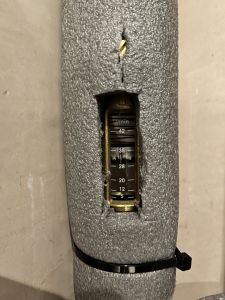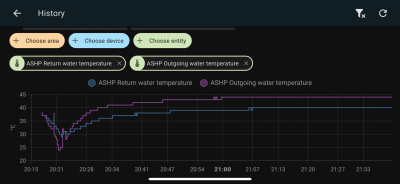Another ASHP Performance Thread - 13kW Grant Aerona
Hi Everyone
New to the forum - having had a cold week wondering why my Grant Heat Pump isn't keeping the house warm in the cold weather.
My heat pump was installed a year ago and so this is our first winter experience with it. The system seems to have been running well all year but the cold snap in late November and again this week have proved to be somewhat challenging for the heat pump - and we've ended up with several plug in electric heaters on the go and still not managed to keep the house at comfortable temperatures.
I have raised this with our installer who came back in December to do a service and connected up the backup heater in the volumiser (aimed at compensating for the frequent defrost cycles) but we're watching the performance to see what further action might be needed.
I'm quite keen to get a better handle on exactly what's going on so have been reading my manual and checking the settings. I was already quite up to speed on the WC settings and have tinkered with it a few times during the year to try to fine tune things. Following the previous cold snap I had set the Max temperature to 50deg at 3deg outside temperature. However, I have only just discovered how to lookup the flow and return temperatures in the control panel and was a bit surprised to see that it was at 40deg today when the outside temperature was around 0 to 1deg. The return temperature was 36.
I feel like it would be useful to collect a lot more data on how my system is performing to support further analysis - I've seen people posting detailed charts of their heat pump's key parameters and am wondering if and how such data can be collected and downloaded from my Grant Aerona system?
Also, now that I've found the flow and return temperatures I've been calculating the heat output using the flow rate but I wanted to check if I'm reading the flow rate correctly - should I be looking at the top or the bottom of the float? Picture below - is this 29l/min or 37l/min?
I'll follow up with some more details in due course but just wanted to pose those two questions in the first instance to try to get my head around what the situation is. Thanks in advance for any pointers.
Grant Aerona3 13kW
If you remove the insulation from around the flow rate indicator, you should be able to see details of the make and model. Google these details and see what information you can find that should hopefully state how to correctly read the device.
The standard flow regulator which comes with the Grant (and I think yours looks like one), you read from the bottom of the float, so 29l/m if I can see correctly. The base of the float in my regulator is clean. There's seems to be some build-up on yours, or maybe that's just the photo?
In terms of getting data from the Grant, it has an RS485 interface (pins 15 and 16 of the outside unit's PCB) which is enabled by default, and this can be used to read most (if not all) of the parameters detailed within the various Grant guides (at the very least, the 10 numbers displayed in user mode of the remote controller) using the modbus protocol. Although be aware that these figures seem to be less precise than those used by the unit itself (e.g. the Outdoor Air Temperature sent over the interface is only to 1 degree granularity, but the remote controller gives the value to nearest 0.5C - possibly a flaw in the on-board implementation of the interface*). I believe an installation of Home Assistant (there may be others) enables this data to be recorded/displayed, but building your own recording system is a fairly simple task, if you're inclined. Wiring up the interface and getting the other end of the cable to somewhere hospitable is probably the trickiest step.
Have a look at this page, which gives an outline of what's involved.
For my own set-up, I have some external grade network capable wired to the HP, going through to this device which is plugged into a Raspberry Pi sitting in a bedroom cupboard. That just runs a script every minute to pull data from the HP and write it to a database for later analysis/display.
*I wonder if the Homely - or Grant's latest 'smart' - controller receive finer data...
QUESTION for @Rupes - have you found any improvement to performance with the backup heater enabled (I presume only for 'defrost' support), and has this increased/reduced overall energy consumption? (I know this is a 'piece of string' question, as there are so many variables).
Grant Aerona 3 10kW
@mikefl Thanks for the response.
I’ll work on the basis of the 29l/min for now - that does seem the more logical - but I’ll see if the installer can confirm too.
I’m inclined to have a go at setting up a modbus connection and Raspberry Pi arrangement. I think I need some meaningful data to be able to figure out what the problem is.
Regarding the “defrost support” - my installer told me that it was set up to only kick in at outside temperatures of -2 and below when the temperature at the volumiser falls below 50deg - so there should have been some occurences this week but without watching it all the time I’ve no idea if it worked or not hence I need to collect some data. It certainly hasn’t noticably improved anything.
Grant Aerona3 13kW
Been approached by a neighbour who has a newly built home with underfloor heating. His Nibe ASHP system is handling heating fine but when the air temp falls below 5 degrees C his hot water really struggles to get above 35 degrees.
I am no expert but my own Nibe system has never struggled with hot water temp. What are the key things to be checking on his as SMO 20 contoller?
@nibemachawk I'm no expert either and not familiar with the Nibe system. Mine is the opposite problem - no problem heating up water and delivering high flow temperatures required but struggles with the heating. But some thoughts...
In terms of what to look out for - my controller clearly shows on the display if it is working to produce heating or hot water. It is set up such that it will only do one or the other at any one time - due to the higher heating needs of the hot water. In addition to the symbols showing on the controller - I can see which zone valve is open (they have LEDs on them in my system). I have three zone valves: radiators, underfloor heating and hot water. Again, when the hot water is being heated, it can be clearly seen that the other two valves are closed. I guess if the system was trying to do both heating and hot water at the same time then it's likely it would struggle to heat up the water sufficiently.
Grant Aerona3 13kW
So, thanks to the suggestion from @mikefl I am now up and running with Home Assistant and a wired connection from my heat pump into an old laptop. Setup was easier than I anticipated in the end.
First chart output here…
I have drawn a few interim conclusions:
- The HP is not performing well at outdoor temperatures below about 3-4deg.
- The HP is not achieving the weather compensation curve at these low temperatures.
- DT seems to be fairly static at 4deg.
- Flow rate is static at about 33l/min (fixed pump speed) although seems to have increased a bit today somehow.
- The heat pump is outputting about 9.5-10kW.
So, given that the house is too cold af these temperatures, how can I access the additional 3kW of rated capacity that my heat pump is supposed to have? Why is it not using this to deliver the higher heat requirement that the WC curve and thermostats are demanding?
Grant Aerona3 13kW
Your conclusions (1) and (2) are probably valid, and common for most ASHPs it seems - the defrost cycles nobble performance, as although they only take 5 minutes to happen, it takes about 20 minutes for performance to recover. If that's happening every 40 minutes, your performance is half what it could be.
DT of 4 is around what I get; obviously varies based on internal temp, and LWT, and is generally wider whilst things are "getting up to speed".
Possibly to get your hands on that 3kW you need to adjust other parameters - I know it can operate in a purely "help with defrost" mode or as "help with heating" (altho obviously that's at a COP of 1 at best). The LLH installation guide (attached)
gives Grant's suggestion for values, so maybe you need to be more aggressive on the temp for turning on? Including Outdoor Air Temp on your graphs to see if it's triggered - although I'm unsure if the value for 'Current Consumption (01 03)' will include the 3Kw from the LLH.
Another thing, less easy to check is how well balanced flows are either side of the LLH. These need to be roughly the same, which can be tricky to achieve when you probably only have 3 to 5 options for flow rate on the secondary side. I've tried to balance mine using temp sensors on the 4 flow/return pipes either side of the LLH, to get something like equal deltaT (and hence about equal flows, given energy must be the same). Unbalanced flows can mean you're recycling return water on one side or another (various topics about this elsewhere on the forum).
Grant Aerona 3 10kW
-
Help needed with Grant Aerona 3 issues
1 week ago
-
New Installation - Grant Aerona 3 + 210L Hot Water Cylinder
2 years ago
-
Grant Aerona 3 Help programing
2 years ago
- 26 Forums
- 2,417 Topics
- 54.8 K Posts
- 318 Online
- 6,096 Members
Join Us!
Worth Watching
Latest Posts
-
MLCP (Multi-Layer Composite Pipe) for ASHP
@editor nope. The info you reported was sufficient for ...
By iotum , 1 hour ago
-
RE: Advice for a novice on Mitsubishi Ecodan 6kW
@robs Quick response while I'm in stationary traffic le...
By Sheriff Fatman , 1 hour ago
-
RE: Setback savings - fact or fiction?
Maths looks right to me, my only question about this ca...
By JamesPa , 2 hours ago
-
RE: Ideal HP290 14kW ASHP - how to optimise
@jamespa I wasn’t offended at all. You are very knowled...
By Davesoa , 2 hours ago
-
RE: Experience - New Build / Complete New Heating System
@vincro I would be surprised if it is much above 5 to 6...
By ASHP-BOBBA , 2 hours ago
-
RE: Recommended home battery inverters + regulatory matters - help requested
Yes, certainly not enough could have been tested in any...
By Batpred , 3 hours ago
-
RE: Post-Traumatic Heat Pump Stress Disorder
Yes bang on and maybe I can illustrate that by way of e...
By iotum , 5 hours ago
-
-

RE: Replacing my 18 month old Hitachi Yutaki ASHP
A big thank you to @jamespa for all his efforts online ...
By trebor12345 , 8 hours ago
-

RE: GSHP WOES! Midland based engineer recommendations?
@editor It is indeed for servicing. My current service ...
By Morgan , 9 hours ago
-
RE: Sunsynk Whole House Backup Issue
Hi @lostandconfused , I agree that topic/thread is the ...
By Batpred , 9 hours ago
-
RE: Speedcomfort radiator fans
In case it helps Andrew Kuhne on openenergy monitor has...
By JamesPa , 10 hours ago
-

Things have gone quiet with you @drei. Any updates?
By Mars , 12 hours ago
-

RE: Passiv Smart Thermostat - Help & Forum Support
Thanks @tim441. Interesting timing, as Passiv are a cur...
By Mars , 14 hours ago
-
Hi everyone, I have a two year old Marlec Solar iBoos...
By Tallmarc , 17 hours ago
-
RE: Please help with the settings ecodan
Are you trying to address any particular performance is...
By Sheriff Fatman , 23 hours ago
-
RE: Solis inverters S6-EH1P: pros and cons and battery options
🤣 Well, I never managed to get the HA solis "...
By Batpred , 24 hours ago
-
RE: Vaillant aroTherm not heating with many faults
@editor hmmm, our engineers Rae, Craig, Naz, Rob and Ry...
By ASHP-BOBBA , 1 day ago






